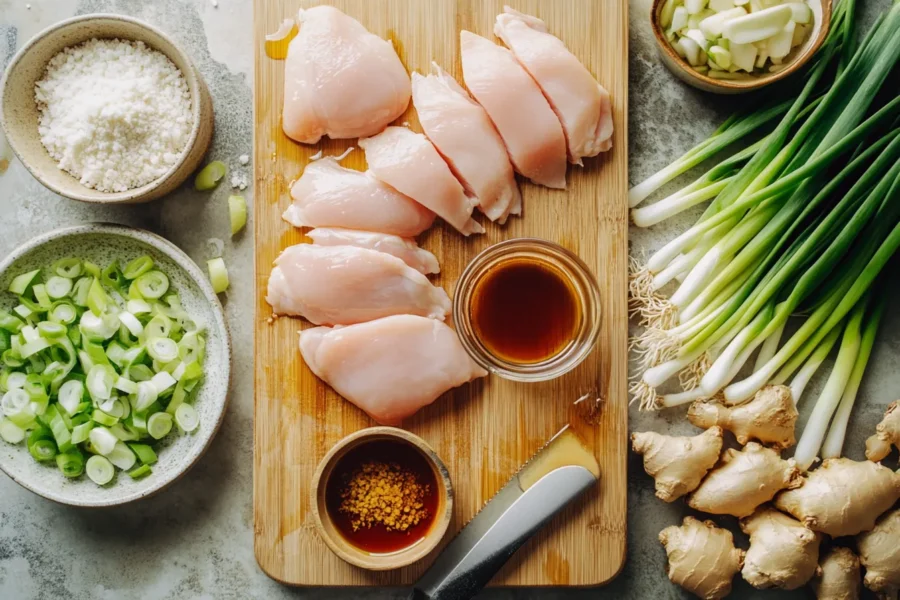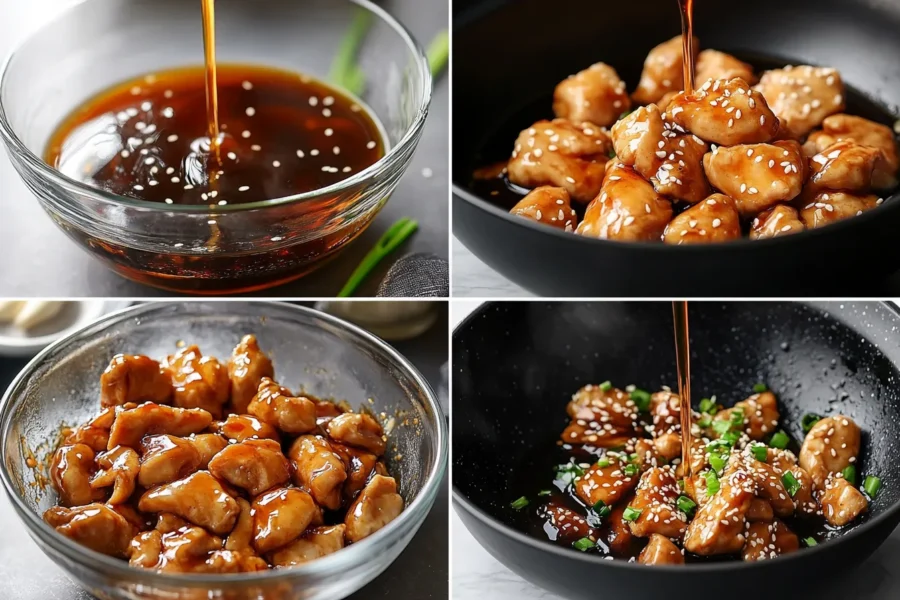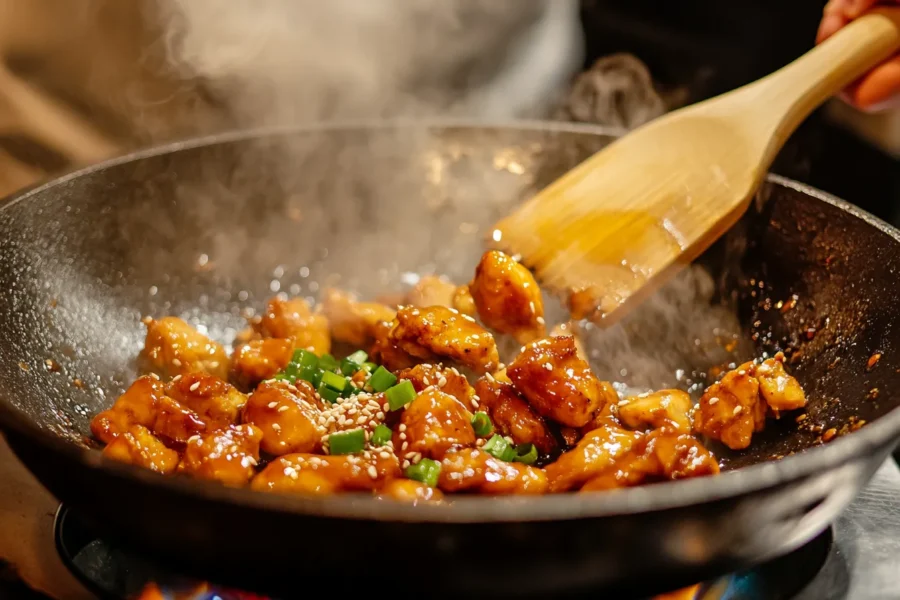A Story That Starts with the Scent of Ginger
There’s something about the scent of ginger chicken sizzling in a pan that transports me back to my childhood. My grandmother’s kitchen was always filled with the rich aroma of fresh ginger, garlic, and soy sauce bubbling together in a wok. She never needed a recipe just a few pinches of this, a splash of that, and somehow, the result was always perfect.
One evening, I remember watching her cook as she told me, “Ginger isn’t just for flavor, it’s for healing.” At the time, I didn’t realize how true that was. Ginger is packed with anti-inflammatory properties, aids digestion, and adds a punch of warmth to any dish. It’s no wonder that ginger chicken has been a staple in many cuisines, from Chinese stir-fries to Indian curries.
But what makes a ginger chicken recipe truly special? It’s all about the right ingredients, the perfect balance of flavors, and the right cooking technique. Whether you’re making it for a quick weeknight dinner or an elegant meal for guests, this dish is easy to make yet packed with flavor.
So, if you’re ready to bring the magic of ginger chicken to your own kitchen, let’s dive into why this dish is a must-try and what makes it so special.
Why You’ll Love This Ginger Chicken Recipe
✔️ Quick & Easy: This dish takes under 30 minutes to prepare. Perfect for busy nights when you want something delicious without spending hours in the kitchen.
✔️ Packed with Flavor: The combination of fresh ginger, garlic, soy sauce, and honey creates a perfect balance of savory, sweet, and spicy.
✔️ Healthy & Nutritious: Ginger is known for its digestive benefits, anti-inflammatory properties, and immune-boosting effects. Plus, chicken is a great lean protein source!
✔️ Customizable: You can adjust the spice level, make it gluten-free, or even swap chicken for tofu or shrimp.
✔️ Pairs Well with Everything: Serve it over steamed rice, noodles, or fresh veggies this dish is versatile and fits any meal plan.
“A good ginger chicken recipe is like a symphony each ingredient playing its part to create a masterpiece of flavors.”
If you’re looking for another flavorful chicken dish, check out this smoked chicken breast recipe for a rich, smoky twist on a classic favorite
The Origin and Popularity of Ginger Chicken
A Brief History of Ginger in Cooking
Ginger has been used in cooking for over 5,000 years, dating back to ancient China and India. It wasn’t just a spice; it was a medicine, a preservative, and even a symbol of wealth.
“In ancient times, ginger was worth its weight in gold, traded across continents as a prized ingredient in food and medicine.”
The spice spread through trade routes, making its way into Middle Eastern, European, and Southeast Asian cuisines. Today, ginger is an essential ingredient in Asian stir-fries, curries, teas, and marinades and, of course, the beloved ginger chicken recipe.
Why Ginger Chicken is a Staple in Asian Cuisine
Ginger chicken has deep roots in Chinese and Indian cooking, but it has also made its way into Thai, Korean, and even Caribbean dishes. Here’s why it’s so popular:
✔️ Balances Flavors: The spiciness of ginger, the umami of soy sauce, and the sweetness of honey create a well-rounded dish.
✔️ Great for Digestion: In many Asian cultures, ginger is used to settle the stomach and aid digestion.
✔️ Works with Different Cooking Methods: Whether you stir-fry, grill, roast, or slow-cook it, ginger chicken always turns out delicious.
Ingredients for the Best Ginger Chicken Recipe
Before we get into how to make this dish, let’s talk about the key ingredients. These are the ones that bring out the authentic flavors of ginger chicken.
| Ingredient | Why It’s Important |
|---|---|
| Chicken Breast/Thighs | Tender and juicy, the base of the dish. |
| Fresh Ginger | The star ingredient, adds warmth and spice. |
| Garlic | Enhances the flavor and aroma. |
| Soy Sauce | Brings in savory, umami depth. |
| Honey or Brown Sugar | Adds a touch of sweetness to balance the spice. |
| Rice Vinegar | Provides acidity to cut through the richness. |
| Sesame Oil | Gives a nutty, aromatic finish. |
| Cornstarch | Helps thicken the sauce and makes the chicken extra tender. |
📌 Full ingredient list with exact measurements is in the recipe card below!

Nutritional Value of Ginger Chicken
If you’re wondering whether ginger chicken is healthy, the answer is YES! It’s packed with protein, antioxidants, and metabolism-boosting properties. Here’s a breakdown:
| Nutrient | Per Serving (1 Cup) |
|---|---|
| Calories | 280 kcal |
| Protein | 27g |
| Carbohydrates | 18g |
| Fats | 9g |
| Fiber | 2g |
| Sodium | 750mg |
“Not only is this dish delicious, but it’s also a great way to boost your immune system and keep your digestion happy!”
What’s Next? Cooking the Perfect Ginger Chicken!
Now that you know why ginger chicken is amazing and what goes into it, it’s time to start cooking! In the next section, we’ll walk through step-by-step instructions to make this delicious, restaurant-style dish at home.
Coming up next:
✅ How to prep the chicken for the best texture
✅ The secret to making a rich, flavorful ginger sauce
✅ Cooking techniques to avoid dry or overcooked chicken
🔔 Stay tuned for Part 2, where we bring all these ingredients together to make the best ginger chicken recipe ever!
How to Make Ginger Chicken: Step-by-Step Guide
Now that we’ve covered why ginger chicken is so popular and the essential ingredients, it’s time to get cooking! Making homemade ginger chicken is incredibly easy, and with just a few steps, you’ll have a dish that tastes just as good if not better than what you’d get at a restaurant.
So, grab your cutting board, wok, and fresh ginger, and let’s get started!

Step 1: Preparing the Chicken
Choosing the Right Chicken
When making ginger chicken, the type of chicken you choose can affect the final texture and flavor. Here’s what you need to know:
✔️ Chicken Thighs: Juicier and more flavorful, perfect for stir-frying.
✔️ Chicken Breast: Leaner but can dry out easily if overcooked.
“For the most tender and juicy ginger chicken, I recommend boneless, skinless chicken thighs. But if you prefer a leaner option, go with chicken breast just be careful not to overcook it!”
Cutting the Chicken for Best Results
1️⃣ Slice Against the Grain – This helps keep the meat tender.
2️⃣ Bite-Sized Pieces – Cut the chicken into thin strips or small cubes so it cooks evenly.
3️⃣ Pat Dry – Remove excess moisture to help the chicken brown better when cooking.
“The secret to restaurant-quality ginger chicken? Cutting the chicken properly. Small, even pieces cook quickly and absorb flavor better!”
Marinating the Chicken for Maximum Flavor
Marinating helps infuse the chicken with flavor and keeps it juicy. Here’s a simple marinade:
Quick Ginger Chicken Marinade
✔️ 2 tbsp soy sauce
✔️ 1 tbsp rice vinegar
✔️ 1 tsp grated fresh ginger
✔️ 1 tsp minced garlic
✔️ ½ tsp sesame oil
✔️ 1 tsp cornstarch
🔹 Let the chicken marinate for at least 15 minutes (or up to 1 hour for deeper flavor).
Step 2: Making the Flavorful Ginger Sauce
The heart of ginger chicken is the sauce. This sauce is a perfect balance of savory, sweet, and slightly spicy flavors.
Ingredients for the Sauce
✔️ ¼ cup soy sauce
✔️ 2 tbsp honey or brown sugar
✔️ 1 tbsp rice vinegar
✔️ 1 tbsp oyster sauce (optional, for extra umami)
✔️ 1 tbsp fresh grated ginger
✔️ 2 cloves garlic, minced
✔️ ½ tsp red pepper flakes (optional, for a little heat)
✔️ ½ cup chicken broth (for extra flavor)
✔️ 1 tsp cornstarch mixed with 2 tbsp water (to thicken the sauce)
“The secret to a glossy, rich sauce? Cornstarch! It thickens the sauce just enough to coat every piece of chicken perfectly.”
Step 3: Cooking Everything to Perfection

Now that everything is prepped, it’s time to bring the magic together!
🔥 Cooking Instructions:
🔹 1. Heat the Pan: Use a wok or large skillet over medium-high heat. Add 1 tbsp of oil.
🔹 2. Cook the Chicken: Sauté the marinated chicken for 4-5 minutes until golden brown. Remove from the pan and set aside.
🔹 3. Sauté the Aromatics: In the same pan, add 1 tsp oil, then sauté the ginger and garlic for 30 seconds until fragrant.
🔹 4. Add the Sauce: Pour in the prepared ginger sauce and bring to a simmer.
🔹 5. Combine Everything: Return the cooked chicken to the pan and toss until coated.
🔹 6. Thicken the Sauce: Stir in the cornstarch slurry and cook for 1 more minute until the sauce is glossy.
🔥 Pro Tip: If you love crispy chicken, lightly coat the chicken in cornstarch before cooking it gives a slight crunch!
Step 4: Garnishing and Serving Tips
Once your ginger chicken is cooked to perfection, it’s time to serve it up!
✔️ Sprinkle with sesame seeds for a nutty crunch.
✔️ Garnish with chopped green onions for extra freshness.
✔️ Drizzle a little extra honey for a touch of sweetness.
“The little details like a sprinkle of sesame seeds or a squeeze of lime can take this dish from great to unforgettable!”
Best Side Dishes to Serve with Ginger Chicken
What pairs well with ginger chicken? Here are some ideas:
| Side Dish | Why It Works |
|---|---|
| Steamed Jasmine Rice | Absorbs the sauce perfectly. |
| Garlic Noodles | Adds extra flavor and texture. |
| Stir-Fried Vegetables | A healthy, colorful addition. |
| Coconut Rice | Sweet and fragrant, balances the spice. |
| Asian Slaw | Crunchy and refreshing contrast. |
“Pairing ginger chicken with the right side makes all the difference go for rice if you want a classic combo, or try noodles for something fun!”
Common Problems and Solutions in Cooking Ginger Chicken
1. Why is My Ginger Chicken Too Salty?
✔️ Use low-sodium soy sauce.
✔️ Add a splash of water or broth to dilute the saltiness.
✔️ Balance it with a little extra honey or lime juice.
2. How to Prevent Overcooked or Dry Chicken?
✔️ Don’t overcook! Remove the chicken once it’s golden brown.
✔️ Use thighs instead of breast for juicier meat.
✔️ Let the chicken marinate longer for more moisture.
3. Balancing Ginger’s Strong Flavor Without Overpowering the Dish
✔️ Use fresh ginger, not powdered it has a milder taste.
✔️ Pair ginger with honey or sugar to balance its spice.
✔️ Start with less ginger, then add more if needed.
“Cooking is all about balance too much salt, spice, or sweetness can throw off the dish. Taste as you go!”
Final Thoughts: Why This Ginger Chicken Recipe is a Must-Try
This ginger chicken recipe is:
✔️ Packed with flavor
✔️ Easy to make in under 30 minutes
✔️ Healthy and full of nutrients
✔️ Versatile great for meal prep, dinner, or special occasions
So, what are you waiting for? Grab your wok, slice up some ginger, and make this delicious dish tonight! 🍛

